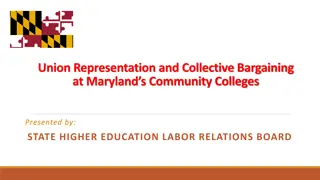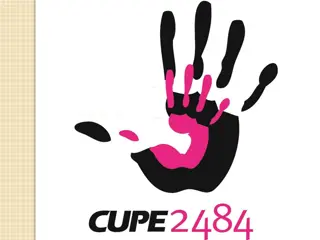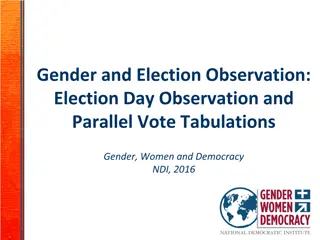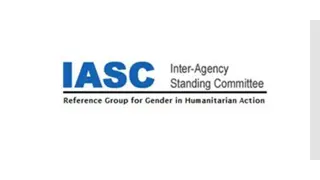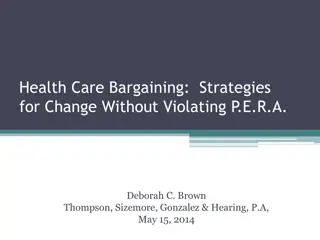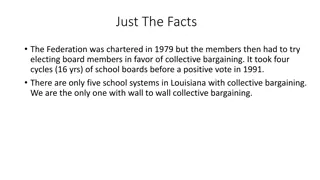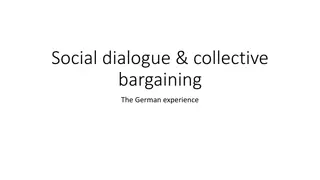Gender Equity and Collective Bargaining for Women Workers
Gender equity and collective bargaining play crucial roles in addressing gender inequality in the workplace. By advocating for fair treatment and opportunities for women, addressing discrimination, and organizing around women workers' rights, these efforts can combat the systemic issues that contribute to women's subordination. The impact of COVID-19 has further highlighted the importance of supporting women workers in the face of economic challenges. Collective bargaining can help reduce the gender pay gap, combat low pay, and ensure workplace safety and equality.
Uploaded on Sep 29, 2024 | 0 Views
Download Presentation

Please find below an Image/Link to download the presentation.
The content on the website is provided AS IS for your information and personal use only. It may not be sold, licensed, or shared on other websites without obtaining consent from the author. Download presentation by click this link. If you encounter any issues during the download, it is possible that the publisher has removed the file from their server.
E N D
Presentation Transcript
Gender Equity and Collective Bargaining
Why Gender Equity Bargaining? Gender inequality = unequal gender power relations and women s subordination: The system of male domination has a social & economic basis, characterised by racism & capitalist exploitation. (COSATU Gender Policy, 2015) Gender Equity means fairness of treatment for women and men, according to their respective needs. This may include equal treatment or treatment that is different but which is considered equivalent in terms of rights, benefits, obligations and opportunities (ILO, 2000) Gender Equity is not the same as equal rights and opportunities for women and men, it recognises their unequal positions and that this requires different treatment to ensure equality in access and outcomes Collective Bargaining can make a significant difference for women workers, by reducing the gender pay gap, combatting low pay, valuing women s work and addressing gender discrimination and safety in the workplace 2
Why engendering bargaining is important Collective bargaining is about the collective power of workers to improve working conditions for all workers Gender and women s issues are union issues Women s work is undervalued and invisible Women make up a significant proportion of precarious workers Gender issues are often overlooked in collective bargaining Taking up issues that affect women may encourage more women to join unions And because women workers matter! 3
A Gendered Bargaining Agenda There are a range of issues that we can take up through collective bargaining to promote gender equity by improving women workers working life and conditions Women workers experience discrimination in the workplace because of their unequal position in society and because of their reproductive role and disproportionate responsibility for care work But there is no one-size-fits-all approach we need to understand women workers different conditions and experiences Organising and fighting for the rights of precarious workers is key The most crucial step in bargaining is to listen to workers and understand their challenges, and to organise and take up the demands of women workers in workplaces 4
Impact of Covid-19 on Women Workers The economic impact on women s employment is devastating almost 2 million (66%) of 3 million jobs were lost to women (Casales & Posel 2020) 46% of women were employed in Feb 2020, by April 2020 36% of women were employed (compared to 59% to 54% for men) Women s working hours declined by 35% compared with 26% for men The impact was highest for vulnerable workers - African women (and men) in low wage jobs the fight against retrenchments is central and urgent! Solidarity with NEHAWU strike for employment of community health workers! The unpaid care burden increased significantly more for women workers Health and safety issues women workers form significant proportion of essential workers - global campaign for PPE that is designed to fit women s bodies Covid-19 has exposed the huge gaps in access to paid sick leave and social protection 5
Health and Safety: Invisible women We must ensure that workers can refuse unsafe work But do we know what is unsafe for women? Gender data bias: studies focus on average male (Criado Perez, 2019) Chemicals in plastics industry, cleaning products and even menstrual pads have been found to cause cancer in women Workplace equipment, uniforms and PPE designed for male bodies Reproductive health rights neglected Women die due to gender data gap in occupational health research We urgently need to collect data on female bodies in the workplace and require that gendered data is used for workplace H&S policies Time off for health care needs, access to mobile clinics, sick leave and medical benefits/NHI Participation in workplace health and safety committees is essential 6
Gender-based Violence and Sexual Harassment The ILO Convention 190 on the Elimination of Violence and Harassment in the world of work covers all workers, including informal economy Violence and harassment can occur during travel to and from work, at social events related to work, or while working outside of the physical workplace The Convention recognises that there are particularly vulnerable groups of workers, including workers dealing with the public, in hospitality, health, transport, education, domestic workers, and those working at night or in isolated areas We must campaign for the Ratification of C190 by our government! Key bargaining issues and advances: COSATU Policy & Procedure for Handling, Prevention & Elimination of Sexual Harassment Workplace GBV and SH policies, with proper procedures & prevention strategies SADTU/ELRC agreement on clear disciplinary processes for educators harassing learners Paid transport for workers GBVF legislation but budgeting for GBV (police, courts, shelters, health) is fundamental 7
Transport Access to safe and affordable transport is critical for working class women s mobility and access to paid work and social services Women are at greater risk of sexual harassment and sexual assault while using public transport The ILO Convention 190 on eliminating violence and harassment in the world of work defines the world of work broadly to include travelling to and from work BCEA provides for transport for night work, but does not stipulate that this should be paid Paid transport to and from work is a critically important collective bargaining demand The demand for accessible, safe and affordable public transport (as part of the social wage/living wage) is an important element of the campaign for women s safety in our communities 8
Gender Wage Gap Women in South Africa earn 70% of what men earn, on average. Women with no education earn half (50%) of what men with no education earn. South Africa has the world s highest wage inequality overall. The average earnings of black people are three times lower than for white people. Given the over-representation of women in low-paying jobs, minimum wages can also make a contribution to lowering gender wage gaps. Minimum wages work best in concert with strong collective bargaining, to ensure that the minimum does not become the maximum. The attack on the public sector - significant impact on gender wage gap! Equal Pay for Equal Work is a key demand and fundamental right Equal Pay for Work of Equal Value is the demand for pay equity work typically done by women is undervalued (as a result of the gender division of labour and association with household work) 9
Parental Rights Parental rights are provisions that help to balance work and family responsibilities for working parents These rights are the result of intense and protracted struggles by workers in the 1980s, when no such rights existed in South African workplaces While we have basic minimum rights enshrined in law, only a few sectors have gone beyond these rights, and most vulnerable workers and labour broker workers cannot access them because they are unpaid Parental Rights include a range of provisions, such as: Job security, Paid parental leave, Family responsibility leave, Social security, Cash benefits, Ante-natal and post-natal care, Health and safety in the workplace, Breastfeeding breaks and facilities, Childcare benefits/facilities Parental rights are important for all workers to ensure that: women are not discriminated against on the grounds of pregnancy women and men are able to participate in all aspects of family and working life infants and children receive the necessary care 10
Employment Equity Affirmative action is necessary to overcome the historical and current inequalities and obstacles faced by disadvantaged groups EEA prohibits unfair discrimination and requires elimination of barriers that constitute discrimination to designated groups Barriers include expectation of long working hours, lack of childcare facilities, non-essential job requirements, facilities that are not available/accessible for women and people with disabilities, equipment not suitable for women and people with disabilities Participation of union representatives in EE committees 11
Social Wage The struggle for a minimum wage should be augmented with the struggle for a social wage, and linked with struggles for access to water, electricity, land, food, comprehensive social security, and decent work. Women have limited access to social security rights, and those in the informal economy, domestic work, and farm work are not protected at all when they fall pregnant or lose their income. COSATU Gender Policy (2015) The social wage includes the following elements: Water, Electricity and Sanitation Health and Education Land and Housing Safe and Affordable Public Transport Social Security provision (childcare grants, pension, unemployment) Universal Basic Income Grant 12
Defending the rights of LGBTI+ workers Equal entitlement to all workplace benefits that other workers have - pensions, family responsibility leave, parental leave, study and housing benefits Recruiting and hiring policies and practices do not discriminate against LGBTI+ workers Disciplinary and grievance procedures that relate to the discrimination and protection of LGBTI+ workers Safe toilets and ablution facilities corresponding to LGBTI+ workers gender identity Training for co-workers and managers on rights of LGBTI+ workers Transgender and gender non-conforming workers have the right to comply with company dress codes in a manner consistent with their gender identity/expression Promotion of gender-neutral or gender and trans-inclusive language 13
Engendering Collective Bargaining Processes Bargaining is never gender neutral Worker control is also about women workers, and is linked to gender democracy and democracy in unions Worker control is a highly participatory form of democracy but it is increasingly being replaced by representative forms of democracy (where worker representatives take decisions on behalf of workers) Participation of women workers in mandating and report-back processes Organising women and vulnerable workers strengthens the power of unions Making a positive link between collective bargaining and equality raises questions about power within unions, the identity of negotiators and office-holders and the extent to which women (and other groups) have power to shape agendas and pursue their concerns. It forces a consideration of women s representation in the trade unions (Dickens, 2000:202) 14
Organising Women Workers There is a vital link between organising and collective bargaining: No bargaining demand can be won without strong organisation To take up demands that workers are willing to fight for, workers need to be well organised Implementation is dependent on power on the ground Without strong organisation the provisions cannot be effectively monitored and implemented Organising women requires making women s issues top priority on the trade union agenda, including gender in all policies, programmes and activities and ensuring equal access for women to decision-making positions. Women will be attracted to membership if they see that unions work for women in practice, addressing their issues and representing them effectively. Trade union organisations should use organising methods suited to the needs of women, and their local conditions. For example, meeting places should be safe and convenient; the timing, agenda and duration of meetings should take account of workers family responsibilities; and, if necessary, care arranged for young children. (ITUC, 2008) 15
Representation of Women in Negotiating Teams It is critical for bargaining teams to be more representative Unions have used various mechanisms to include more women in negotiations, such as additional positions, company-based gender reps But representation alone is not enough We need bargaining representatives that are: Gender Conscious and aware of women workers concerns Able to advance arguments in support of gendered demands Trained in negotiating strategies Supported and backed by the union and bargaining teams This applies to all bargaining team members, it is not only the responsibility of women to advanced gendered demands 16
Building Solidarity Solidarity is essential to collective action and bargaining One definition of solidarity is a shared commitment to take collective action for change But a more expansive way of looking at solidarity is willingness to take action in support of other workers, even if it is not in your direct and immediate interest to do so Key to the future of the labour movement, is the understanding that all workers long-term interests are connected and this is the only way to build worker s strength and unity For the survival of trade unions, we must organise and fight for all workers, including and especially vulnerable and precarious workers and women workers We need a strong and united trade union movement that is able to advance all workers struggles collectively 17




